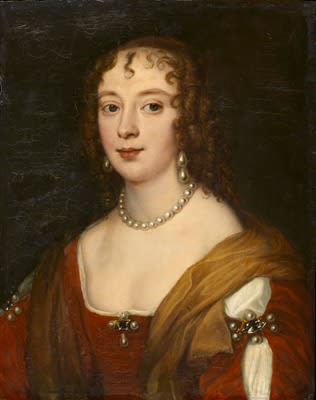
Remigius van Leemput
Portrait of Anne, Lady Russell, later Countess of Bedford (1615-84), mid 17th century
Oil on canvas
15.3/2 x 12 ½ inches, 40cm x 32cm
Philip Mould & Co.
To view all current artworks for sale visit philipmould.com Remigius Van Leemput, otherwise known as ‘Remy’, ‘Remee’ or ‘Old Remy, was a highly accomplished painter working in seventeenth century...
To view all current artworks for sale visit philipmould.com
Remigius Van Leemput, otherwise known as ‘Remy’, ‘Remee’ or ‘Old Remy, was a highly accomplished painter working in seventeenth century England, and a celebrated copyist of the works of Sir Anthony Van Dyck (1599-1641) and Sir Peter Lely (1618-80).
Leemput was baptized in Antwerp in 1607 and by 1635 was living in Covent Garden, London, which is when, perhaps, he began working in the studio of Van Dyck, who arrived in England three years earlier. Very little is known about the pupils who trained and worked with Van Dyck, although it is generally acknowledged that Leemput was employed to assist with the preliminary development of his works and also as a copyist.
As well as a successful painter, Leemput was also a prominent collector and dealer, purchasing Van Dyck’s colossal ‘Charles I with M. de S Antoine’ [Royal Collection] following Charles I’s execution, although, thankfully, Leemput was unable to find a buyer abroad, and the work was later reclaimed at the Restoration.
A label of the reverse of the present work, mis-identifies the sitter as ‘Mrs Blount/by Remy’, which perhaps refers to Elizabeth, wife of Sir Walter Blount, 1st Baronet Blount, who was a prominent Royalist. Instead, the portrait actually derives from Van Dyck’s portrait of Anne, Lady Russell, painted c.1638-9 [Clifton Castle, Yorkshire], and would have been painted in response to the increasing demand in the mid-late seventeenth century for smaller copies, or ‘closet pictures’, relating to Van Dyck’s work. In these smaller works, minor details, which would have better suited larger, more flowing compositions, were truncated, and we notice here for example how Leemput has omitted a fluid white garment worn beneath the low-cut bodice in the original, in favour of a more neatly presented bodice with a jewel at the breast.
Interestingly, Vertue records a copy by Leemput ‘in small’ of Van Dyck’s full-length portrait of Anne’s father-in-law Francis Russell, 4th Earl of Bedford (1593-1641), and it is quite possible that they were, perhaps, commissioned around the same time.
Anne was born in the Tower of London where her mother, Frances Howard (1590-1632), was imprisoned for the murder of Sir Thomas Overbury, an advisor who attempted to prevent the annulment of her unhappy marriage with Robert Devereux, 3rd Earl of Essex. Anne married William Russell, 5th Earl of Bedford, in 1637, and was styled Countess of Bedford from 1641 following her husband’s accession to the earldom.
Remigius Van Leemput, otherwise known as ‘Remy’, ‘Remee’ or ‘Old Remy, was a highly accomplished painter working in seventeenth century England, and a celebrated copyist of the works of Sir Anthony Van Dyck (1599-1641) and Sir Peter Lely (1618-80).
Leemput was baptized in Antwerp in 1607 and by 1635 was living in Covent Garden, London, which is when, perhaps, he began working in the studio of Van Dyck, who arrived in England three years earlier. Very little is known about the pupils who trained and worked with Van Dyck, although it is generally acknowledged that Leemput was employed to assist with the preliminary development of his works and also as a copyist.
As well as a successful painter, Leemput was also a prominent collector and dealer, purchasing Van Dyck’s colossal ‘Charles I with M. de S Antoine’ [Royal Collection] following Charles I’s execution, although, thankfully, Leemput was unable to find a buyer abroad, and the work was later reclaimed at the Restoration.
A label of the reverse of the present work, mis-identifies the sitter as ‘Mrs Blount/by Remy’, which perhaps refers to Elizabeth, wife of Sir Walter Blount, 1st Baronet Blount, who was a prominent Royalist. Instead, the portrait actually derives from Van Dyck’s portrait of Anne, Lady Russell, painted c.1638-9 [Clifton Castle, Yorkshire], and would have been painted in response to the increasing demand in the mid-late seventeenth century for smaller copies, or ‘closet pictures’, relating to Van Dyck’s work. In these smaller works, minor details, which would have better suited larger, more flowing compositions, were truncated, and we notice here for example how Leemput has omitted a fluid white garment worn beneath the low-cut bodice in the original, in favour of a more neatly presented bodice with a jewel at the breast.
Interestingly, Vertue records a copy by Leemput ‘in small’ of Van Dyck’s full-length portrait of Anne’s father-in-law Francis Russell, 4th Earl of Bedford (1593-1641), and it is quite possible that they were, perhaps, commissioned around the same time.
Anne was born in the Tower of London where her mother, Frances Howard (1590-1632), was imprisoned for the murder of Sir Thomas Overbury, an advisor who attempted to prevent the annulment of her unhappy marriage with Robert Devereux, 3rd Earl of Essex. Anne married William Russell, 5th Earl of Bedford, in 1637, and was styled Countess of Bedford from 1641 following her husband’s accession to the earldom.
Be the first to hear about our available artworks
* denotes required fields
We will process the personal data you have supplied in accordance with our privacy policy (available on request). You can unsubscribe or change your preferences at any time by clicking the link in our emails.